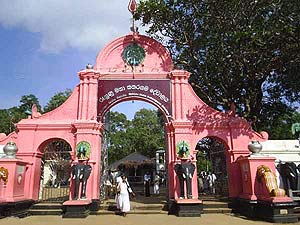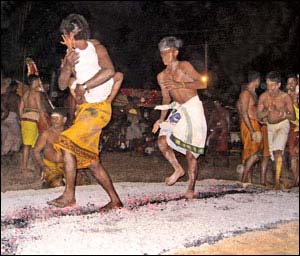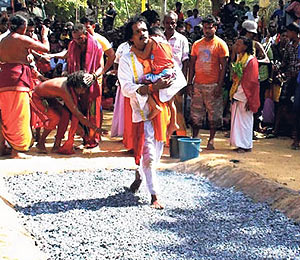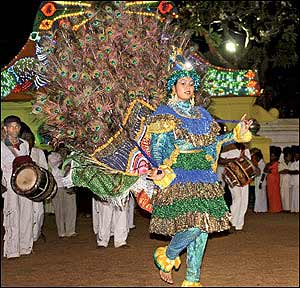|
| ||||||||||||||

The Magic of Kataragamaby Ravi NagahawatteKataragama is a place where religious beliefs and cultures from North and South harmoniously blend.
The city’s charm, in the form of retaining its old magic, and the holiness, the place resonates drive a sense of seriousness into any traveler setting foot here. Devout pilgrims will vouch that God Kataragama has the power to intervene in the lives of humans and provide them with solace to problems which otherwise, as these devotees believe, wouldn’t have solutions. Most devotees make simple offerings like fruits and coconuts to God Kataragama. Devotees are expected to make themselves clean by taking a bath in the Menik Ganga before the pooja, an act which devotees say removes their sins and makes them ready to worship Lord Kataragama. Devotees also make offerings to God at Sella Kataragama, a Hindu place of worship, which is situated in close proximity of Menik Ganga. A striking feature about the crowds is that there are Sinhalese and Tamils, some coming from faraway places like the Jaffna Peninsula. And what’s even more amazing is that there isn’t a clash of cultures when worshiping God. The event that brings the crowds here from all parts of the country is known as Pada Yatra, a journey which begins from faraway places 45 days prior to the festival. Devotees can be seen suspended by hooks, being carried in carts. Some walk on fire while some chose to roll on the road at a time when the sun is scorching hot. Those who have intense faith in God Kataragama vouch no harm comes their way when performing these devotional acts, however astonishing and sometimes frightening they might seem to onlookers.
The city of Kataragama and the shrine have been spoken of since the days of King Dutugemunu (161-137 BC). Legend has it that King Dutugemunu built this shrine following a series of battles against Dravidian invaders. Legend also has it that Lord Kataragama is a local chieftain who became a deity. Buddhists also believe that Lord Kataragama is a Buddha aspirant and is now living in the form of a deity till the time is rife for him to become the next Buddha. Buddhists are divided on the topic of worshipping Gods and seeking favors from them. Those Buddhists who believe in deities claim the Majjima Nikaya (A religious manual read by Buddhists) has provisions for worshipping gods. They claim that the Buddha has said that making offerings to Gods will bring benefits to those seeking Samadhi. So in keeping with the contents in the sacred Buddhist texts, the traditions practiced in the Kataragama Devale (Shrine) give first preference to making an offering to the Buddha before the pooja is kept for Lord Kataragama. Seasoned devotees opine that if one is mentally ready and also lucky there is a remote chance of getting a glimpse of Lord Kataragama. Such popular talk has it that Lord Kataragama sometimes walks among the devotees taking the form of an old man. One person who claims to have seen this God is the late Ananda Maitreya Thera. Even if the majority doesn’t have this experience of having a Lord Kataragama sighting, there are enough opportunities to mingle with Sadus, Babas and holy men who join the crowds in their numbers during these two holy months. However, Hindus believe the five senses have their limitations and as a result they can’t assist humans in making contact with God. They believe the only way to do this is by enhancing the capacity of the human mind which then enables them to understand God’s presence and work. There were frowns in the faces of villages and devotees when the government, some years ago, granted licenses for individuals to mine for gems in Menik Ganga. This opposition to gem mining in the sacred river surfaced because many believe that Kataragama belongs to the God and nothing should be taken out of this sacred city. Kataragama is also listed as one of 16 sites for Buddhist pilgrimage in Sri Lanka. Devotees are expected to come with open minds and show respect to priests, swamis, kapuralas (lay officials forming religious ceremonies) and fellow devotees and leave the scared place with more wisdom than they came with. Each visit to Kataragama brings with it an entirely new and memorable experience. The choice of hotels in the vicinity of the sacred town of Kataragama had reached the 500 mark when this writer visited this place back in 2011. There are some businessmen who make this pilgrimage once a month. Their devotion to God is so much that they insist on booking the same room in the same hotel during every visit, regardless of whether the room was comfortable or had its shortcomings. Businessmen believe that when some form of link is made with God, it’s best not to change anything in the equation. This standing order every month with the hotel management has everything to do with prayers being answered. Courtesy: The Nation of 13 July 2014 |
|



 The city of Kataragama resembles an island, recovering from a war, of a different kind of peace which can be experienced by surrendering oneself to God. The majority Sinhalese from Western, Central and Southern Provinces and the minority Tamils from the North and East follow an inner instinct to travel long distances to reach Kataragama during this time of the year. Every year, in June-July, this sacred city attracts devotees in thousands for an event known as the Esala Festival. On the final day of the festival all the excitement is reaches a climax with the water-cutting ceremony.
The city of Kataragama resembles an island, recovering from a war, of a different kind of peace which can be experienced by surrendering oneself to God. The majority Sinhalese from Western, Central and Southern Provinces and the minority Tamils from the North and East follow an inner instinct to travel long distances to reach Kataragama during this time of the year. Every year, in June-July, this sacred city attracts devotees in thousands for an event known as the Esala Festival. On the final day of the festival all the excitement is reaches a climax with the water-cutting ceremony.
